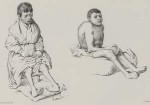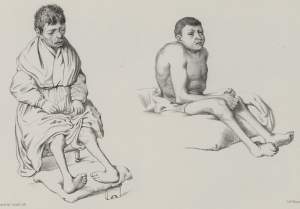
 Deux aliénés atteints de cachexie, Augustin Bénédict Morel, Traité des dégénérescence physiques, intellectuelles, et morales de l'espèce humaine, 1857, p.48, BIU Santé.Did excess mortality among the Great War insane result from a political choice?
Deux aliénés atteints de cachexie, Augustin Bénédict Morel, Traité des dégénérescence physiques, intellectuelles, et morales de l'espèce humaine, 1857, p.48, BIU Santé.Did excess mortality among the Great War insane result from a political choice?
During World War I, the asylums caring for patients with mental illness registered significant mortality rates. This category bore, in France and Belgium, the brunt of diverse Great War policies. In light of this observation, it is interesting to see in which way the warring countries’ policies did impact mortality in their asylums.
Mortality was the scourge of mental homes during and after WWI. At Le Mans, 350 patients died between June 1918 and June 1919, which is 40% of the asylum’s population at the time. All the institutions were affected by this excess mortality. Some asylums, viz Rennes, Mayenne, or, say Nancy had a mortality rate of 10 to 15% in 1918, whereas at Le Mans, Bron or Albi the rate was twice as high. Mortality depended on the condition of the asylum regarding the war zone. In hospitals behind enemy lines, mortality was high as figures for Prémontré (Aisne) show below.
All internees did not benefit from the same treatments. There was an inequality in the care delivery, between mentally disturbed soldiers and long-standing mentally ill civilians. Soldiers were treated as a priority by the alienists as they were to return to the front as soon as possible to defend the homeland. This resulted in lower mortality among the military than civilian cases. At Le Mans, 25% of the soldiers died when the average overall was 40%.
Further distinctions are to be made between countries. In Belgium, under German occupation and subject to a commercial blockade, the civil population’s mortality rate is estimated at 1.2% between 1914 and 1918, while it is 20 times higher among the insane. Indeed, though the CNSA (National Relief and Food Committee) handled rationing and supplied supplementary rations to infants, “feeble-minded” children, pregnant women, TB sufferers and prisoners, it made no provisions for the insane. That difference in treatment is significant. In June 1918, the bread ration for the insane is 260 grammes per day whereas “feeble-minded” children received 400 grammes. There is a view that the CNSA has failed in its relief effort, thus explaining the famine among forgotten asylum populations.
This excess mortality resulted from several factors. First malnutrition. Nutritional deficiencies were caused by the homes’ restricted means and by food rationing. Under the occupation, the asylums were ransacked, their land, coal, material goods and food were requisitioned by the German invader. At Prémontré, an Aisne town under German occupation, the excess mortality is glaring. There would be 763 deaths between 1914 and 1916, of which 539 were recorded between 1st January and 8th December 1915. Military plunder had an undeniable impact on the famine.
The second cause of excess mortality was the overpopulation in mental asylums, further compounded by the transfer of the frontline insane to the rear. In a context of requisitions and a growing patient population, the food became sparser and sparser. After 4 September 1914, around 5600 mentally ill patients out of 15500 interned in the Seine were evacuated. Closeness to the front drove evacuations as the German took over the establishments to billet their troops. Furthermore, some Paris asylums took in the war-wounded. This required the evacuation of the insane to make room for the military. The mad are dependent on society whereas the military defends the fatherland; therefore, soldiers are more worthy of support than lunatics.
Underfed, the body is weakened and vulnerable to disease. Overpopulation and mass movement favour the spread of disease. Accordingly, the 1918 flu pandemics wrought havoc among the insane. At Ville-Évrard out of the 150 patients affected 26 died of the Spanish flu, which took its toll on nursing staff as well.
Throughout the war, aid was set up towards the disadvantaged populations, young children TB sufferers, war-widows… However, neither the elderly nor the insane were included in such relief efforts, for these groups were not deemed useful to society. It is therefore plain to see that our governments made choices during the Great War which politicians long failed to answer for, notably in Belgium. As historians have shown, the same dilemma would play out with tragic implications during the Second World War.
To follow on the dictionnary : Intelligence test
To read the paper in french : Surmortalité asilaire
Références :
Anne Roekens, Benoît Majerus, Vulnérables, Presses Universitaires de Namur, 2018.
Stéphane Tison, “ Loin du front, la folie ? Les civils internés à l’asile durant la Grande Guerre”, Guerres mondiales et conflits contemporains, 2015, vol. 257, n°1, p. 13-36.
To quote this paper : Titouan Bois, "Excess mortality in psychiatric hospitals" in Hervé Guillemain (ed.), DicoPolHiS, Le Mans Université, 2021.